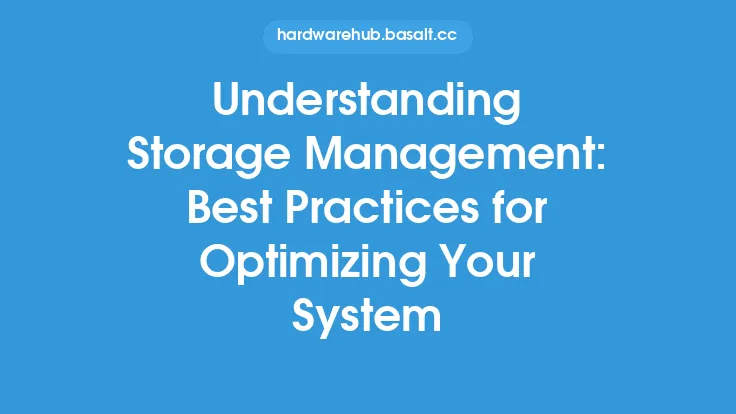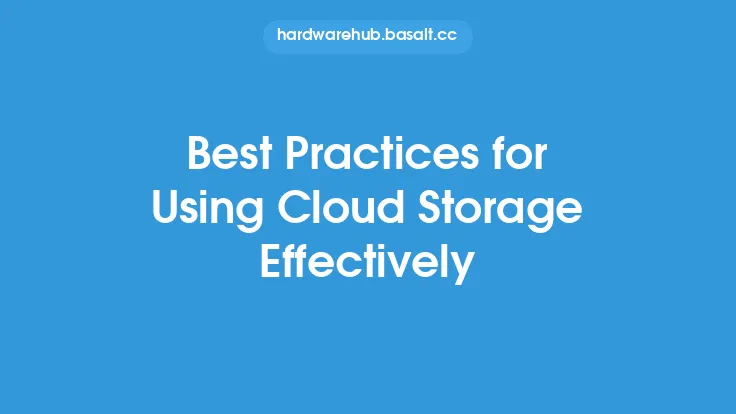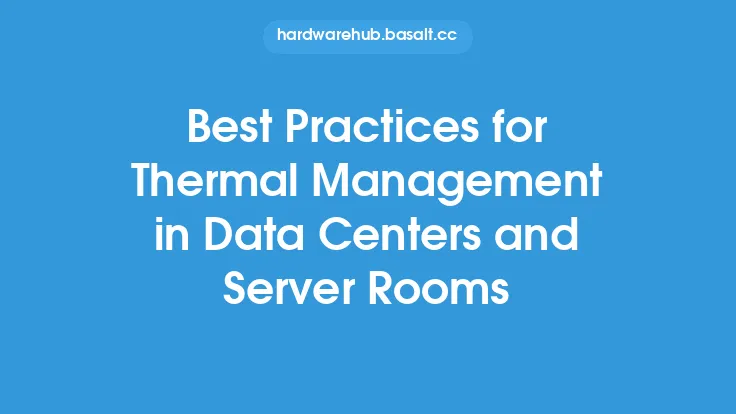Implementing a storage management plan is crucial for organizations to ensure efficient use of storage resources, reduce costs, and improve data accessibility. A well-planned storage management strategy helps to optimize storage capacity, reduce data redundancy, and improve data protection. In this article, we will discuss the best practices for implementing a storage management plan that meets the needs of your organization.
Introduction to Storage Management Planning
Storage management planning involves assessing the current storage infrastructure, identifying areas for improvement, and developing a strategy to optimize storage resources. It requires a thorough understanding of the organization's data storage needs, data growth patterns, and storage infrastructure. A good storage management plan should be aligned with the organization's overall IT strategy and goals. It should also be flexible enough to adapt to changing business needs and technological advancements.
Assessing Current Storage Infrastructure
The first step in implementing a storage management plan is to assess the current storage infrastructure. This involves identifying the types of storage devices used, storage capacity, data usage patterns, and storage protocols. It is essential to gather information about the current storage environment, including the number of storage devices, storage capacity, and data growth rates. This information will help to identify areas for improvement and develop a strategy to optimize storage resources.
Developing a Storage Management Strategy
Developing a storage management strategy involves setting clear goals and objectives, identifying storage requirements, and selecting the right storage technologies. The strategy should be based on the organization's business needs, data growth patterns, and storage infrastructure. It should also take into account the organization's budget, scalability requirements, and data protection needs. A good storage management strategy should include provisions for data backup, disaster recovery, and business continuity.
Implementing Storage Management Best Practices
Implementing storage management best practices is crucial to ensure efficient use of storage resources and improve data accessibility. Some of the best practices include:
- Data deduplication and compression to reduce storage capacity requirements
- Thin provisioning to optimize storage allocation
- Storage virtualization to improve storage utilization and reduce complexity
- Automated storage tiering to optimize data placement and reduce costs
- Data replication and mirroring to improve data protection and availability
- Regular storage monitoring and reporting to identify areas for improvement
Selecting the Right Storage Technologies
Selecting the right storage technologies is critical to implementing a storage management plan. The choice of storage technology depends on the organization's storage needs, data growth patterns, and budget. Some of the popular storage technologies include:
- Hard disk drives (HDDs) for high-capacity storage
- Solid-state drives (SSDs) for high-performance storage
- Flash storage for low-latency and high-throughput applications
- Cloud storage for scalable and on-demand storage
- Hybrid storage for combining different storage technologies
Managing Storage Capacity and Performance
Managing storage capacity and performance is essential to ensure efficient use of storage resources and improve data accessibility. This involves monitoring storage capacity, identifying areas for improvement, and optimizing storage performance. Some of the techniques used to manage storage capacity and performance include:
- Storage capacity planning to ensure adequate storage capacity
- Storage performance monitoring to identify bottlenecks and optimize performance
- Storage optimization techniques such as data deduplication and compression
- Storage tiering to optimize data placement and reduce costs
Ensuring Data Protection and Availability
Ensuring data protection and availability is critical to implementing a storage management plan. This involves developing a data protection strategy, implementing data backup and recovery procedures, and ensuring business continuity. Some of the techniques used to ensure data protection and availability include:
- Data replication and mirroring to improve data protection and availability
- Data backup and recovery to ensure business continuity
- Disaster recovery planning to ensure rapid recovery in case of disasters
- Data encryption to protect sensitive data
Monitoring and Reporting Storage Performance
Monitoring and reporting storage performance is essential to ensure efficient use of storage resources and improve data accessibility. This involves monitoring storage capacity, performance, and data protection. Some of the tools used to monitor and report storage performance include:
- Storage management software to monitor storage capacity and performance
- Performance monitoring tools to identify bottlenecks and optimize performance
- Reporting tools to provide insights into storage usage and performance
Conclusion
Implementing a storage management plan is crucial for organizations to ensure efficient use of storage resources, reduce costs, and improve data accessibility. A well-planned storage management strategy helps to optimize storage capacity, reduce data redundancy, and improve data protection. By following the best practices outlined in this article, organizations can develop a storage management plan that meets their needs and ensures efficient use of storage resources. Regular monitoring and reporting of storage performance are essential to ensure that the storage management plan is effective and aligned with the organization's overall IT strategy and goals.





